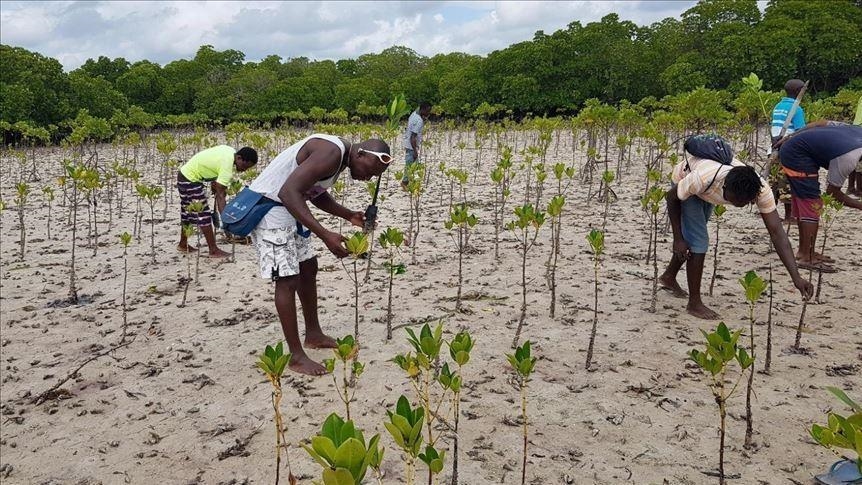‘Transformed my life’: Tanzania’s farmers adapt to new climate reality with agroforestry
As climate shocks disrupt livelihoods, farmers in Tanzania’s Mbeya and Morogoro regions are embracing agroforestry as a lifeline

- ‘Agroforestry has transformed my life. We eat avocados every day, and for the first time, I can pay school fees without begging,’ says farmer Mary Gasper Mkwama
- ‘Global pledges mean nothing if farmers cannot survive,’ says Tanzanian academic Pius Yanda, calling for action from leaders at the upcoming UN climate summit
MBEYA, Tanzania
In the cracked plains of Mbarali, southern Tanzania, the ruins of a once-bountiful rice belt tell a stark story: climate change has arrived and become everyday life.
Mothers sell goats to buy maize flour; elders remember when the Ruaha River ran year-round; youth question whether rice farming can ever flourish again under such duress.
“When the river dried, we lost everything,” said Anna Mbwambo, a middle-aged farmer as she shelled groundnuts beside her thatched house. “We used to get three harvests, now we are lucky with one. The price of rice has doubled. Who can survive like this?”
A severe drought in 2015-17 slashed yields across Tanzania’s Mbeya region, drove food costs upward, and left lingering scars.
“The youth are discouraged,” said village elder Josephat Ndimila, glancing at the shallow Ruaha. “They no longer believe rice can feed the future.”
Yet not all hope has perished. Some farmers farther east, on the slopes of the Uluguru Mountains in Morogoro, are embracing agroforestry as a lifeline.
“Agroforestry has transformed my life,” said Mary Gasper Mkwama, 50, walking amid avocado trees intercropped with maize and beans. Her three-acre plot is part of an initiative by local non-profit Agriwezesha, which has planted more than 440,000 trees – avocado, pine, grevillea, and cypress – in Morogoro to stabilize slopes, feed households, and buffer climate extremes.
In peak season, Mkwama’s income surged from 600,000 Tanzanian shillings ($245) to 3.2 million shillings ($1,300). “We eat avocados every day,” she laughed, “and for the first time I can pay school fees without begging.”
Still, success is uneven. Neighbor Peter Clavery Luanda, also cultivating avocados, laments that fruits often rot before buyers arrive. “Sometimes there are no buyers. The fruits rot. We lose everything,” he told Anadolu.
While traders cite oversupply and weak market access as key constraints, frustration simmers in Mbeya.
“We are told to plant drought-tolerant seeds,” said Margaret Mlowe, a mother of three. “But where do we get them? We cannot afford irrigation, we cannot afford fertilizer. We are on our own.”
Landscapes in crisis
Tanzania’s climate stress is not unique. In April 2024, the UN Environment Programme reported that severe drought across the country caused massive crop failures and animal losses, followed by extreme rains that triggered floods, infrastructure damage, and water contamination.
At the continental scale, the World Meteorological Organization warned in its 2025 State of the Climate in Africa report that droughts and floods are inflicting mounting damage across the region. It pointed out that some of the driest conditions on record are overlapping with record heat, eroding agricultural resilience.
Moreover, April 2025 data from the Global Drought Observatory shows that meteorological droughts are especially persistent in Southern Africa and in river basins like the Zambezi, affecting food zones already weakened by successive dry seasons.
When examined together, these patterns paint a continent under mounting hydrological stress. In Southern Africa, 2023-24 was declared one of the worst droughts in over a century, compounding food insecurity for millions.
Within Tanzania, tree loss compounds the strain: the UN Food and Agriculture Organization estimates Tanzania loses some 400,000 hectares of forest annually, undermining both watershed health and local rainfall retention.
Cultivating resilience
Experts and activists argue that agroforestry offers a powerful adaptation strategy, but only if structural support follows.
Pius Yanda of the University of Dar es Salaam said integrating trees and crops helps buffer climate shocks while rehabilitating degraded lands.
“It’s a pathway to adaptation across many climate scenarios,” he said.
Deograsia Ignas, Agriwezesha’s co-founder, emphasized that trees must pay, not just grow: “Farmers invest time and money, but sell produce at low prices. We need fair trade and training, otherwise their hard work will not pay off.”
Women, in particular, have embraced resilience from the ground up. In Mvomero, 28-year-old Jackrina Mzedu mixes pine, avocado, and vegetables with traditional pest remedies.
“Trees keep soil moist. Even when the rains stop, crops survive,” she said.
In Mbeya, women trek longer to fetch water, but lead groups building microdams and shared seed banks. “The trees give us firewood closer to home,” said Zawadi Elias. “Before, we walked for hours. Now we save time for farming.”
Conservation authorities note that forests in the Ulugurus feed rivers that supply millions of people, including the commercial hub of Dar es Salaam. “If the reserve goes, so do we,” warned Proches Simon Elias of the Tanzania Forest Service.
Amid these challenges, a few young Mbeya farmers are trialing short-cycle rice varieties for rapid harvests. “We cannot give up,” said 25-year-old Daniel Mwangwa. “This is our land. But we need help.”
As the next UN climate summit (COP30) looms in Brazil, Yanda emphasized that “global pledges mean nothing if farmers cannot survive.”
“We need real finance for adaptation: water systems, early warning, fair markets,” he said.
Anadolu Agency website contains only a portion of the news stories offered to subscribers in the AA News Broadcasting System (HAS), and in summarized form. Please contact us for subscription options.







